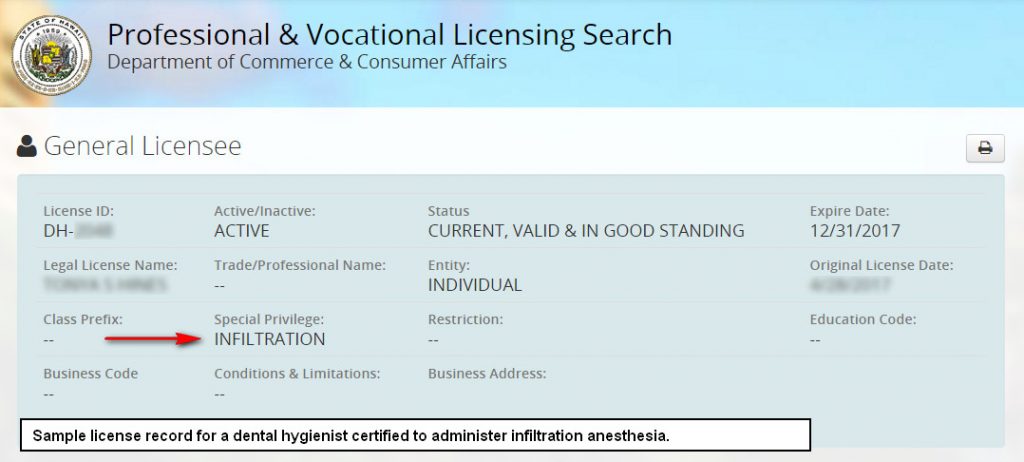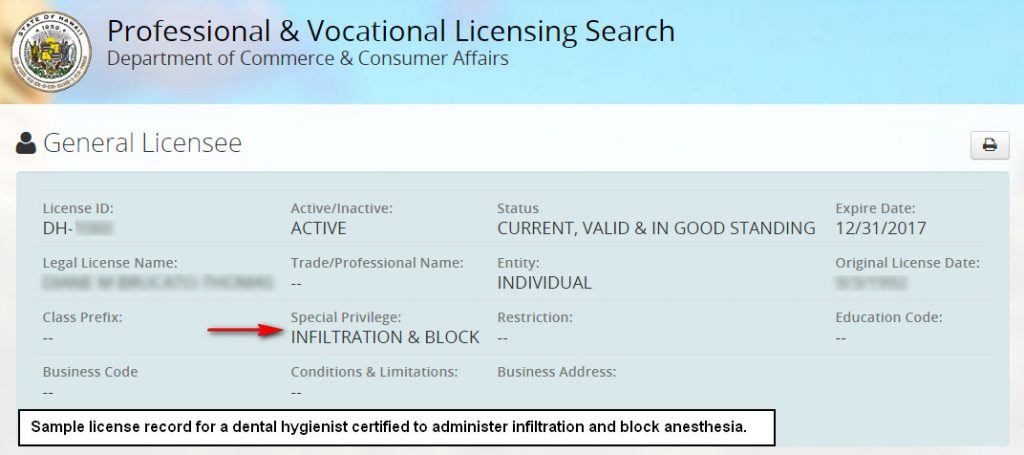Licensed Dentists and Dental Hygienists
Dentists work to restore and maintain dental health by diagnosing, treating, and operating on, pains, injuries, deformities, diseases, and physical conditions of the oral and maxillofacial area. (Includes the teeth, gums, jaws, and other areas of the head and neck as long as the mouth is involved.) In the State of Hawaii, a license is required to work as a dentist.
Dental hygienists work to remove hard and soft deposits and stains, apply preventive chemical agents to the coronal surfaces of teeth and polish surfaces of the teeth. A license is required to work as a dental hygienist. A certificate of licensure must be displayed in the workplace.
Dental assistants. A dentist may employ a dental assistant to perform certain supportive procedures, such as preparing procedural trays, helping to retract oral tissues, and removing debris during dental procedures. A license is not required to work as a dental assistant in Hawaii.
What can dental assistants do? A dental assistant must work under the direct supervision of a licensed dentist and cannot perform any work within the scope of practice of a licensed dental hygienist. A dental assistant cannot administer local anesthesia, sedation, or general anesthesia. For a complete list of allowable and prohibited practices for dental assistants, consult the Hawaii laws and rules related to the practice of dentistry. You can also contact the Hawaii Board of Dental Examiners at (808) 586-2702.
Important Information about Anesthesia and Sedation. A dentist may recommend medication to help you have a more relaxed and comfortable dental experience. Some drugs control pain, some help you relax, and others put you in a deep sleep. Before receiving anesthesia or sedation, ask your dentist what you will be receiving and who will be administering it. Then, be sure to check licensure with the Regulated Industries Complaints Office. The following are some basic guidelines for required licensure:
Local anesthesia. There are two types of local anesthesia – intra-oral infiltration local anesthesia or intra-oral block anesthesia. Any licensed dentist can administer intra-oral infiltration local anesthesia or intra-oral block anesthesia.
A licensed dental hygienist (1) certified by the Hawaii Dental Board and (2) working under the direct supervision of a licensed dentist can also administer intra-oral infiltration local anesthesia or intra-oral block anesthesia. Be sure to check licensing records to confirm the dental hygienist is properly licensed and certified.
General anesthesia, deep sedation, and moderate sedation. General anesthesia, deep sedation, and moderate sedation are all designed to help the patient relax and to minimize discomfort during a procedure. Only a licensed dentist with a permit from the Hawaii Board of Dental Examiners can administer general anesthesia, deep sedation, or moderate sedation.
A dental assistant can never administer local anesthesia, sedation, or general anesthesia.
How do you know if a dentist or dental hygienist is licensed, if a dental hygienist is certified to give infiltration injections or block injections, or if a dentist is certified to administer general anesthesia or deep or moderate sedation? Consumers can check licensing information by calling (808) 587-4272 or online at cca.hawaii.gov/rico/business_online.
Effective July 1, 2017, licensed dentists who administer general anesthesia, deep sedation, or moderate (conscious) sedation, are required by law to post a notice containing contact information for the RICO Consumer Resource Center (see Act 106 (Session Laws of Hawaii 2017)). A sample notice is provided here: Sample Notice (Act 106 (SLH 2017)).
RICO relies on information from consumers to monitor conduct in the industry and to watch for unlicensed activity. For information about filing a complaint, click on the link below or call the RICO Consumer Resource Center to speak with an intake investigator about your complaint.


